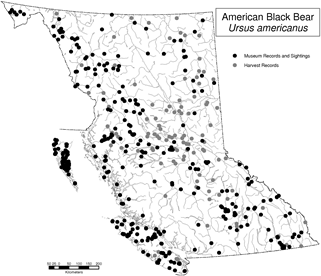The Black Bear is a solitary species that is active throughout the day. It is found across most of North America and throughout British Columbia. It is one of the most readily seen and easily identified large wildlife species in the province. It has noticeable rounded ears, small eyes, a large snout, thick legs, large flat-soled feet and a very small tail (Hatler et al. 2008). Not all Black Bears are black--they may be blonde, cinnamon, brown or black, and some may have a v-shaped white patch on the chest. The Kermode Bear or Spirit Bear, which is a Black Bear, can be white.
At a distance, smaller Black Bears can look like a large dog. Small Black Bears may be confused with Grizzly Bears; sometimes it is difficult to separate larger lighter-coloured Black Bears from Grizzly Bears. The most reliable feature for separation is the large hump over the shoulders on grizzlies and their much longer front claws. View a photo of grizzly bear claws.
Habitat:
The Black Bear is a forest species throughout its range, but forages in a variety of habitats, including forest (conifer swamps, hardwoods) and shrub areas, shrub-steppe, ridgetops, shorelines, and riparian areas (Hatler et al. 2008, Wikipedia 2011).
Taxonomy:
Five subspecies of the Black Bear are recognized in BC (Hatler et al. 2008), including the Kermode or Spirit Bear of the central and north coast and adjacent islands (Hatler et al. 2008). One in ten Kermode Bears are white or cream-coloured. The five subspecies are:
1) Ursus americanus altifrontalis (coast form)
2) Ursus americanus carlottae (Queen Charlotte Islands)
3) Ursus americanus cinnamomum (most of BC east of the coast mountains)
4) Ursus americanus kermodei(mainland coast of BC and adjacent islands, from Burke Channel to the Nass River)
5) Ursus americanus vancouveri (Vancouver Island and larger adjacent islands).
However, recent genetic work does not appear to support these distinctions but rather supports two genetic groups: a coastal group and a continental group. Further work on the taxonomy of the Black Bear is needed. For further information on this, please refer to Hatler et al. (2008).
Notes:
The highest recorded density of Black Bears in western North America is from a coastal island off of Washington State where 12 to 15 bears per km square has been reported. Bears play a significant ecological role as dispersal agents through their consumption of plant seeds. Seeds consumed by bears reportedly have higher germination rates (Hatler et al. 2008). Bears also contribute to nutrient levels in associated ecosystems, both through nutrients in their feces and through salmon carcasses they leave behind that decompose and further add nutrients to the soil (Hatler et al. 2008).
View a video of the black bear by Rod Innes.
